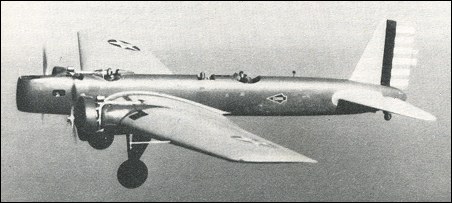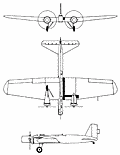 |
Boeing Model 214, 215, 246 / YB-9, Y1B-91931 |  |
| BOMBER | Virtual Aircraft Museum / USA / Boeing |
 |
In 1930 Boeing began the private-venture development of a bomber aircraft that, hopefully, would succeed in gaining a worthwhile military order. To achieve outstanding performance, it was decided to base its design on the revolutionary Model 200 Monomail and, in effect, the resulting prototypes and service evaluation bombers were scaled-up versions of this aircraft. They differed by having a twin-engined powerplant, installed in nacelles at the wing leading edge, and by adaptation of the slender fuselage to cater for the crew and weapons. To provide the crew accommodation, the fuselage was extended well forward of the wing. A bomb-aimer/gunner was accommodated in the nose and immediately behind him, within the fuselage, was a radio operator's position. Aft of the radio operator were two cockpits in tandem, for pilot and co-pilot, with a fourth open cockpit, just aft of the wing trailing edge, for the rear gunner. A bombload totalling 1025kg could be divided between an internal bomb bay and underwing racks. First to fly was the Boeing Model 215, on 13 April 1931, powered by two 429kW Pratt & Whitney R-1860-13 Hornet radials. This was tested by the USAAC under the initial designation XB-901 (Experimental Bomber), and satisfactory conclusion of testing resulted in the procurement of this aircraft under the designation YB-9. At the same time the then incomplete Boeing Model 214 was contracted under the designation Y1B-9, plus five additional service test aircraft with the designation Y1B-9A (Model 246). The Model 214, powered by 447kW Curtiss V-1570-29 Conqueror inline engines, was flown for the first time on 5 November 1931, and following further tests, the Model 214 was re-engined with a supercharged version of , the Pratt & Whitney Hornet. This power-plant was chosen also for the Y1B-9As, the first of which was flown on 14 July 1932. This latter version differed externally from the earlier prototypes in having modified vertical tail surfaces, and had internally a number of equipment and structural changes to meet service requirements. Subsequent testing, and evaluation against the Martin Model 123, resulted in the latter aircraft entering service as the B-10. This came as a great disappointment to the Boeing company, which had produced this first revolutionary bomber with performance superior to most contemporary fighter aircraft. However, this small B-9 family marked the very beginning of the company's specialisation in bomber design. Boeing Model 214, 215, 246 / YB-9, Y1B-9 on YOUTUBE
|  COMPANY PROFILE | ||||||||||||||||||||||||||||||||||||||||||||||||||||||
 |

|

